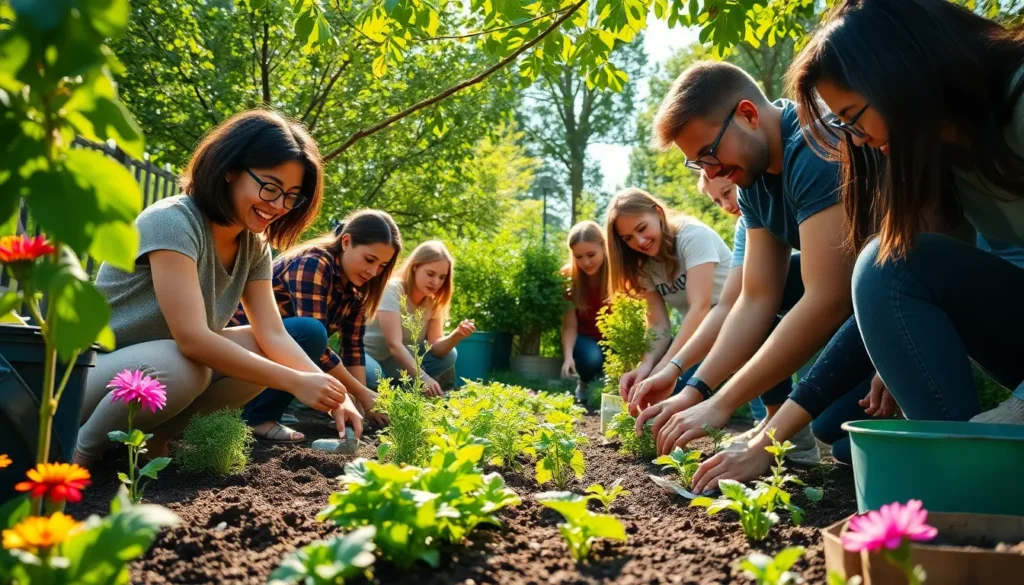In a world where plastic bags seem to multiply like rabbits and carbon emissions are as common as that one friend who always shows up late, it’s time to take a stand. Sustainable living isn’t just a buzzword thrown around at eco-friendly brunches; it’s a lifestyle that can save the planet and maybe even your sanity. Who knew saving the Earth could be this much fun?
Table of Contents
ToggleUnderstanding Sustainable Living
Sustainable living embodies practices aimed at minimizing negative impacts on the environment. This lifestyle focuses on reducing waste, conserving resources, and decreasing carbon emissions. Emphasizing mindful consumption fosters a habit of making eco-friendly choices in daily life.
Adopting renewable energy sources, such as solar or wind, significantly contributes to reducing reliance on fossil fuels. Choosing clean energy options lowers greenhouse gas emissions and promotes environmental health. Each household transitioning to green energy helps the collective effort against climate change.
Sustainable transportation offers another avenue for reducing carbon footprints. Utilizing public transit, biking, or walking reduces automobile dependency. Carpooling with others also minimizes individual carbon emissions.
Moreover, responsible consumption plays a crucial role in sustainability. Individuals can support local, organic farms to decrease transportation emissions associated with conventional food sourcing. Selecting reusable products over disposable ones not only reduces waste but also conserves resources.
Proper waste management practices aid in fostering a sustainable environment. Recycling and composting organic waste reduces landfill contributions while enriching soil health. Local recycling programs can guide individuals on how to dispose of materials responsibly.
Cultivating a sustainable lifestyle extends to personal habits as well. Mindful dietary choices, like incorporating plant-based foods, support both health and environmental well-being. Each small change contributes positively towards a larger goal of sustainable living.
Engaging in community efforts also enhances the impact of individual actions. Joining or initiating local sustainability initiatives empowers individuals to learn from each other and promote best practices. Collective action boosts awareness and effectiveness in reducing overall carbon footprints.
Tips for Sustainable Living and Reducing Carbon Footprint

Sustainable living can significantly reduce carbon footprints and promote a healthier planet. Here are some practical strategies that can help.
Energy Efficiency at Home
Improving energy efficiency at home makes a substantial difference in reducing carbon emissions. Switch to LED light bulbs, which use up to 75% less energy than traditional bulbs. Install smart thermostats to optimize heating and cooling without sacrificing comfort. Appliances certified by ENERGY STAR consume less electricity, leading to lower energy bills and reduced emissions. Seal windows and doors to prevent drafts, ensuring homes retain heat during winter and cool air in summer. Regularly review energy usage habits and identify areas for improvement, contributing to a more eco-friendly household.
Sustainable Transportation Options
Choosing sustainable transportation options helps decrease carbon footprints significantly. Public transit provides a cost-effective and eco-friendly alternative to single-occupancy vehicles. Biking promotes health and cuts emissions, particularly for short trips. Walking remains the simplest way to reduce carbon output and improve personal fitness simultaneously. Carpooling reduces the number of vehicles on the road, resulting in lower emissions per person. Electric vehicles (EVs) offer another option, producing zero tailpipe emissions. Each of these choices encourages greener commuting while benefitting individual well-being.
Waste Reduction Strategies
Implementing waste reduction strategies can drastically minimize landfill contributions. Start by practicing recycling, ensuring materials like glass, plastic, and paper are correctly sorted and processed. Composting kitchen scraps enriches the soil while keeping organic waste out of landfills. Opt for reusable bags, bottles, and containers instead of single-use items to reduce plastic waste. Prioritize purchases with minimal packaging and support brands that emphasize sustainable practices. Education about waste management within the community enhances overall efforts, creating a culture centered on sustainability. Each small action feeds into a larger movement toward reduced waste.
Incorporating Sustainable Practices in Daily Life
Incorporating sustainable practices in daily life allows individuals to significantly reduce their carbon footprints while enjoying the journey. Simple changes make a big difference, promoting a healthier planet.
Mindful Consumption
Mindful consumption involves making conscious choices about products and services. Focus on purchasing only what’s necessary, reducing waste and excess packaging. Embrace quality over quantity by investing in durable items that last longer. Choosing second-hand or upcycled products further minimizes environmental impact. Engaging in local swap events can extend the life of goods within the community, promoting sharing and reuse.
Supporting Local and Organic Products
Supporting local and organic products strengthens the community and promotes sustainable agriculture. Local farmers often grow food in season, reducing transportation emissions associated with long-distance shipping. Organic products come with fewer pesticides and chemicals, benefiting both health and the environment. Choosing to shop at farmers’ markets connects individuals directly with producers, fostering a sense of community. Many communities now host CSA programs, allowing consumers to source fresh produce directly from nearby farms.
The Role of Community in Sustainability
Community involvement significantly enhances efforts toward sustainability. Local initiatives often drive collective actions, leading to more substantial impacts than individual efforts. Joining community gardens allows individuals to learn about regenerative agricultural practices while growing their own organic food. Workshops on recycling and composting further educate members about waste management strategies, directly reducing landfill contributions.
Participating in neighborhood clean-up events fosters a sense of ownership and pride in local environments. Through these efforts, residents connect with one another, forming networks that prioritize sustainability. Collaborating with local organizations strengthens advocacy for eco-friendly policies, leveraging collective voices for greater influence.
Engaging in local sustainability initiatives cultivates awareness and motivates behavioral changes. Neighbors sharing resources, tools, and knowledge reduces consumption and waste. By supporting local farmers, community members decrease transportation emissions while promoting sustainable agriculture. Farmers’ markets and community-supported agriculture (CSA) programs create direct connections between consumers and producers.
Creating awareness campaigns about the importance of reducing carbon footprints encourages participation from diverse community members. Clean energy projects, such as solar cooperatives, allow collective investment in renewable energy, leading to lower utility costs and reduced greenhouse gas emissions.
Each person contributes to a larger mission when communities band together for sustainability. Local challenges, like food insecurity or pollution, can drive collaborative problem-solving. Through shared experiences and responsibilities, communities can achieve significant progress in protecting the environment.
Embracing sustainable living is a powerful way to make a positive impact on the environment. By adopting simple yet effective practices individuals can significantly reduce their carbon footprints while enjoying the process. Every effort counts from mindful consumption to supporting local initiatives and utilizing renewable energy sources.
Communities play a vital role in fostering sustainable habits and creating a collective movement towards a greener future. When people come together to share resources and knowledge they amplify their efforts and inspire others to join the cause. The journey toward sustainability is not just a personal responsibility but a shared mission that can lead to lasting change for the planet.






